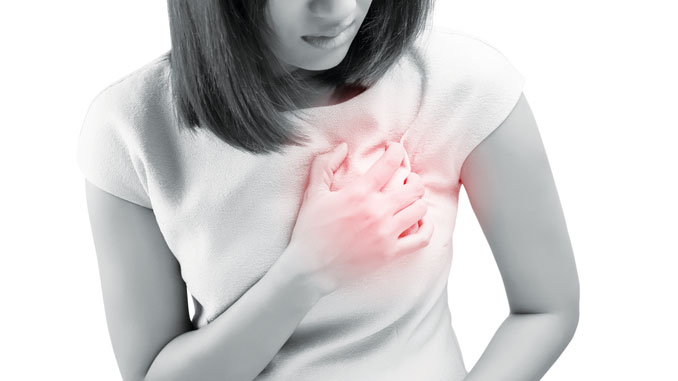
Achieve cardiovascular health with help from local experts, and a little bit of cardio.
A sudden squeezing pain in the chest, tightness that spreads to the left arm, a wave of dizziness, shortness of breath.
These are the symptoms most sufferers feel when they have a heart attack. The problem is the symptoms are sudden; they only come on when a heart attack is in full swing. For most, there are no warning signs of cardiovascular disease before the event, no small shocks leading up to the big boom. Heart disease is called the silent killer.
“We’re very sensitive to things that happen around us in our environment,” says Eric Keyser, MD, medical director of the Stanford Cardiac Surgery Program at Dameron Hospital and Stanford clinical assistant professor of cardiothoracic surgery. On the inside, our bodies harbor the warning signs of heart disease but on the outside there’s no way to tell. “It’s only when its become a critical issue, a functional issue, we become aware that it is a problem.”
“With the increasing degree of people not being active… people are becoming less aware they are having a heart attack,” Dr. Keyser says. They are not used to exerting themselves and chest pain is not as obvious. “Sometimes heart attack symptoms can be as subtle as just feeling unwell or feeling weak.”
One in three women will have heart disease in their lifetime. That’s more than cancers, car accidents, and stroke. Fifty percent of the time, the first sign of heart disease is sudden cardiac death. Hypertension is the most dangerous form, as most people do not feel hypertension until they suddenly have a stroke or heart attack. Because they don’t feel it, they do nothing to prevent it. However, hypertension is still doing the damage and screwing up the organs. “Most people have hypertension even five years without symptoms,” warns Dr. Ramin Manshadi, author of The Wisdom of Heart Health: Attaining a Healthy and Robust Heart, and cardiologist at Manshadi Heart Institute in Stockton.
Even with genetic markers that can increase the instance of heart attack, prevention is possible. A healthy lifestyle is the best defense against heart disease and an even better defense for minimizing the effects of heart disease on the body. Eating vegetables, exercising regularly, and avoiding unhealthy habits such as smoking and drinking alcohol help lower risks for both men and women.
A proper cardio fitness routine has also been linked to improved cardiovascular health. As little as 30 minutes of cardio three times each week can greatly reduce the chances an individual will develop a heart-related illness.
So why does it work? Cardiovascular exercise reduces the risk of suffering from medical conditions that can impact your heart health such as diabetes, high cholesterol, high blood pressure, and obesity. Reducing the risk of developing these diseases removes strain from the heart that can wear it out and lead to a heart attack.
The American Society of Sports Medicine states every individual in the U.S. should do a minimum of 30 minutes of moderate physical activity each day or 150 minutes each week. “If you do that, there are significant reductions in cardiovascular mortality and morbidity,” says Dr. Manshadi.
The key word is moderate. Light exercise, for most, isn’t enough, and strenuous activity can wear down the heart.
For runners, three to five mph is a moderate speed. Isometric exercises such as push-up and sit-ups are also a positive. There should be a mix of weight training and resistance exercises in every heart-healthy exercise routine.
How it Works
Lets look at this in medical terms for a minute. Regular, moderate exercise benefits the lipid profile (lipids include cholesterol and triglycerides), and reduces bad particles that cause blockages in the arteries, which leads to heart attack, and raises good cholesterol. “Exercise by itself makes the inner lining of the arteries more healthy,” Dr. Manshadi explains. It helps the arteries relax during stress or other times blood pressure rises. With moderate exercise, hypertension rates are lower, reducing risk for stroke and heart attack.
Think of it as a sort of conditioning for your heart muscles. When the heart is conditioned to manage a sudden spike in blood pressure, a small decrease in oxygen, or other environmental changes, the fallout is less severe. For many, stress builds to a point the heart can no longer take and gives out, but if you exercise, your heart muscles will know how to manage the extra stress without sending you in a giant red taxi to the hospital.
Weight control is the other part of this equation. Obesity increases the risk of heart attack by approximately 60 percent in middle-aged men, according to a University of Glasgow study. Extra weight puts strain on the organs and diets high in fatty foods that cause obesity clog the arteries. Weight control not only creates more positive outcomes for those who suffer myocardial infarctions, it reduces the risk of diabetes, a main culprit for heart attacks.
Getting started
Ian Fisher, owner of The Shop Fitness in Lodi, makes it simple. “Get moving,” he says. “Twenty to 30 minutes a day on a piece of cardio equipment at a moderate pace… you don’t need to overdo it.” One of the biggest mistakes people make is doing too much too fast, which puts additional stress on the body.
Adding light weight lifting or resistance training to your routine breaks down and builds muscle. “The more muscle mass you have in your body, the more calories you burn everyday,” Ian says. And while weight loss isn’t the only goal, it is part of maintaining a healthy heart. Smaller waistlines and less belly fat greatly reduce the risk of cardiovascular disease, including heart attacks.
For those who already have heart disease, regular exercise reduces the severity of preexisting conditions by strengthening the heart and cardiovascular system and improving circulation. Reversal of angina and other issues is possible, but even without full reversal, adopting a healthy cardiovascular exercise routine can prevent worsening of the disease.
Remember, the heart is a muscle and it needs to be properly worked just like biceps and glutes.
When a person has cardiovascular disease, is at risk for cardiovascular disease, or has lived a sedentary lifestyle for a long period of time, taking it slow is important. These patients should never start a new exercise routine without consulting a healthcare professional. Dr. Keyser also suggests spending more time on warm-up and cool down and being more measured in your approach to exercise by avoiding excessive strength training “because it puts an extra strain on the vascular system and an extra strain on the heart.”
Diversification of exercise is another important step. Well-rounded exercise routines add resistance training twice per week for about 30 minutes each session to further reduce risk.
Diversified workouts keep your body from getting bored. As bodies adapt to repetitive exercise, those exercises become less effective and new exercises should be introduced to keep your body on its toes and work new muscle groups.
Lifting weights, isometric exercises such as planks, and TRX all develop muscular strength, which reduces the risk of breaks. Any type of cardiovascular exercise resets how much oxygen you need to perform an activity. You get tired and fatigued faster when you do not exercise. “As we age, all our reserve goes down,” Dr. Manshadi says. “[Resistance training] will help the muscles to be more efficient.”
Exercise is so important that a 50-year-old with a healthy exercise routine can be in better physiological shape than a 25-year-old who doesn’t exercise.
If people are sedentary, they have to start slow. Moving from an inactive lifestyle to an active one is risky, but necessary.
Start with walking. Once you’ve built up some strength, move on to moderate exercise such as racket sports, basketball, soccer, and moderately intensive yoga. Don’t jump into vigorous exercise like cross fit, which is only good for the body if you work up to it.
The goal is 30 minutes per day but if you need to take it down a notch, 15 minutes will do in the beginning, according to Ian. It’s hard but you will find a balance between stepping outside of your comfort zone and doing more than your body can handle.
Too much too fast can lead to injury or simply turn people off to the idea of exercise. “Do what you can do until your body builds up the strength,” Ian suggests.
Building Strength
Even after an individual has built up strength and become a more effective exerciser, it’s still possible to take it too far. “When you overdo it, you stress your body out,” Ian says. This releases stress hormones, which is the opposite of what you want to achieve cardiac health. Instead of spending hours in the gym each day, Ian recommends working out for 45 minutes at a reasonable pace. Too much muscle breakdown, overtraining, injuries, and exhaustion are counterproductive to the process.
Better Heart Care for San Joaquin County Residents
In October 2017, Dameron Hospital announced the launch of the Stanford Cardiac Surgery Program at Dameron Hospital. Through the partnership, a joint cardiothoracic surgery program with Stanford Medicine physicians in the Stockton hospital, patients in San Joaquin County will receive improved cardiac care.
This opportunity brings state-of- the-art medical procedures and technology to the local community to enhance its quality of care and the overall patient care experience. Through the Stanford Cardiac Surgery Program, patients are able to undergo surgical procedures previously unavailable to them at Dameron Hospital. It reduces the need to travel outside of the area to receive cardiac care, adding a sense of ease and reduced stress to those with cardiac disease.
Through the new partnership, Stanford’s leading edge patient care, research, and care innovations will be available in Stockton. Previously, residents frequently left the area to access the level of care provided by world-renowned medical institutions such as Stanford Health Care, and now, they don’t have to. “This program will give members of our community a much better option—locally, without having to leave,” says Lorraine Auerbach, president and CEO of Dameron Hospital.
The partnership is part of an initiative Stanford has launched to bring its services outside of the Bay Area. As a result, Stanford Professor and Cardiothoracic Surgeon Dr. Eric Keyser operates a full-time practice at Dameron Hospital in Stockton at 530 W. Acacia St., Ste. 23.
Not All Heart Attacks are Created Equal
We see it in the movies; the sudden gripping of the chest, falling to the knees, an immediate inability to breathe. It’s what we all recognize a heart attack to look like. The problem is, not all heart attacks look this way, especially for women.
The American Heart Association as well as local hospitals has made it their mission to spread awareness of heart disease, to reduce the risk of sudden cardiac death through education.
Many women who experience heart attacks never feel pain in their chests and weakness in their arms, jaw, and chest. These, of course, are the most common signs of a heart attack, but they are by no means a cookie-cutter reaction.
Some women describe an increase in stress, a feeling of impending doom, and increased fatigue as symptoms experienced before a heart attack. Sometimes symptoms are gastrointestinal. In too many cases, these patients do not get to the doctor in time because their symptoms are atypical.
Dr. Keyser explains it best. At any time something feels off, especially in the chest, and does not improve with rest, or keeps coming back, head to the hospital. Lightheadedness, chest pain, dizziness, and cold sweats can be signs of something less severe, however, they can also be warnings of cardiac arrest to come.
His suggestion: if it feels out of the ordinary, doesn’t improve with rest, and is persistent, it’s important to follow up with a doctor. If pain is severe, go to an emergency room right away. Symptoms can be subtle.




